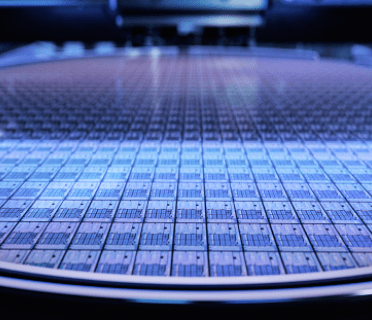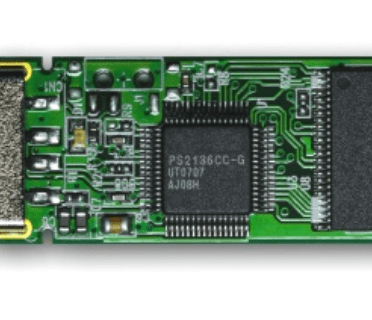Czym jest pamięć flash USB?
Definicja pamięci flash USB
Pamięci flash USB – znane również jako pendrive – to kompaktowe, przenośne urządzenia do przechowywania danych, które wykorzystują pamięć flash do przechowywania informacji.
Są one wyposażone w interfejs USB (ang. Universal Serial Bus, uniwersalna magistrala szeregowa) i są powszechnie kompatybilne z komputerami i innymi urządzeniami wyposażonymi w porty USB – pod warunkiem że mają to samo złącze – co czyni je wszechstronnym narzędziem do przesyłania danych i tworzenia kopii zapasowych. Dyski te w niezawodny sposób umożliwiają przenoszenie, udostępnianie i ochronę treści, takich jak dokumenty, zdjęcia i filmy, ze względu na ich trwałość i brak ruchomych części.
Dyski flash USB o pojemności do kilku gigabajtów mogą pomóc w realizacji różnorodnych potrzeb związanych z przechowywaniem danych, od szybkiego przesyłania plików po rozbudowane rozwiązania do tworzenia kopii zapasowych danych. Ich funkcjonalność plug-and-play umożliwia łatwe uruchomienie poprzez podłączenie do portu USB bez potrzeby instalowania sterowników lub oprogramowania.
Czy dysk flash USB jest odpowiedni dla mnie?
Zastanawiasz się, czy dodać napęd flash USB do swojej strategii tworzenia kopii zapasowych? Odkryj przypadki użycia, które mogą uświadomić Ci, że dyski flash USB będą właściwym wyborem do zapisywania i udostępniania treści.
Przenośna kopia zapasowa
Jeśli szukasz prostego sposobu na tworzenie kopii zapasowych ważnych plików, takich jak dokumenty, zdjęcia lub kontakty, dysk flash USB może być rozwiązaniem dla Ciebie. Jest kompaktowy i łatwy w przenoszeniu, dzięki czemu Twoje dane są zawsze w zasięgu ręki.
Szybkie przesyłanie danych
Musisz szybko przenosić pliki między komputerami lub innymi kompatybilnymi urządzeniami bez stałej łączności z Internetem. Dyski flash USB mogą stanowić szybkie i niezawodne rozwiązanie z funkcją plug-and-play oraz możliwością natychmiastowego przesyłania danych i łatwego dostępu.
Bezpieczne przechowywanie danych
Martwisz się o bezpieczeństwo wrażliwych informacji podczas podróży? Rozważ dysk flash USB z szyfrowaniem i ochroną hasłem, aby zabezpieczyć swoje dane przed nieautoryzowanym dostępem.
Udostępnianie multimediów
Uwielbiasz udostępniać duże pliki, takie jak filmy i obrazy o wysokiej rozdzielczości, bez utraty jakości? Dyski flash USB zapewniają wygodny i wydajny sposób dystrybucji multimediów wśród znajomych, rodziny lub współpracowników.
Awaryjne nośniki rozruchowe
Entuzjaści technologii lub specjaliści IT, którzy potrzebują niezawodnego narzędzia do naprawy komputera lub diagnostyki, mogą wykorzystać dyski flash USB do tworzenia nośników rozruchowych, ułatwiając szybkie i wydajne odzyskiwanie systemu.
Prezenty na wydarzenia
Planujesz wydarzenie lub szukasz produktów promocyjnych z logo marki? Dyski flash USB z oznaczeniem marki to praktyczne prezenty, oferujące podwójną korzyść w postaci użyteczności i reklamy Twojej marki.
Narzędzia edukacyjne
Nauczyciele i uczniowie mogą korzystać z pamięci flash USB do wymiany treści kursowych i zasobów edukacyjnych, zapewniając łatwy dostęp do niezbędnych materiałów bez uzależnienia od Internetu.
Samochodowe systemy multimedialne
Jeśli Twój samochód jest wyposażony w port USB do podłączenia nośnika z muzyką lub rejestracji nagrań z kamery, dysk flash USB może być doskonałym wyborem. Może stanowić proste rozwiązanie do zarządzania nagraniami wideo, dodawania muzyki lokalnie i nie tylko.
Historia dysków flash USB

Pod koniec lat 90. rewolucja w branży komputerów osobistych sprawiła, że użytkownicy potrzebowali większej pojemności niż dyskietki i napędy Zip – a także pamięci masowej, która była bardziej kompatybilna z różnymi urządzeniami.

Na przełomie tysiącleci dyski flash USB stały się rozwiązaniem łączącym dwie nowe technologie: pamięć flash NAND, wynalezioną w 1987 roku, oraz protokół USB, opracowany w połowie lat 90.

Opierając się na tych nowych technologiach, firma M-Systems wprowadziła w 1999 roku pierwszy na świecie dysk flash USB, DiskOnKey. Ten wynalazek był kamieniem milowym w przenośnym przechowywaniu danych i stanowił kompaktowe, łatwe w użyciu rozwiązanie do przesyłania i przechowywania multimediów.

Dyski flash USB znacznie rozwinęły się od czasu pierwszego urządzenia o pojemności 8 MB sprzedanego w 2000 roku. Firmy takie jak SanDisk zwiększyły pojemność do 1 TB i zaprojektowały modele wyposażone w złącza USB-C, micro-USB i Lightning.
Zalety i wady dysków flash USB
Zastanawiasz się, czy dodać napęd flash USB do swojej strategii tworzenia kopii zapasowych? Odkryj przypadki użycia, które mogą uświadomić Ci, że dyski flash USB będą właściwym wyborem do zapisywania i udostępniania treści.
Zalety pamięci flash USB
Wady pamięci flash USB
- Możliwość przenoszenia: Dyski flash USB są małe i lekkie, dzięki czemu umożliwiają łatwy i bezpieczny transport danych.
- Zgodność z szeroką gamą urządzeń: Dzięki opcjom zgodnym z najnowszymi standardami USB, napędy flash USB zapewniają dużą prędkość i funkcjonalność plug-and-play w większości systemów.
- Pojemność: Dyski flash USB mogą być małe, ale modele o pojemności do 1 TB pozwalają zapisać znaczne ilości danych.
- Trwałość: Brak ruchomych części sprawia, że napędy flash USB są odporne na wstrząsy fizyczne i zużycie w porównaniu z tradycyjnymi mechanicznymi dyskami twardymi.
- Przechowywanie danych: Dzięki nieulotnej pamięci flash mogą one przechowywać dane przez długi czas bez zasilania.
- Ograniczone cykle zapisu: Pamięć flash ma skończoną liczbę cykli zapisu/wymazywania, co oznacza, że pamięć flash USB w końcu się zużywa.
- Zagrożenia dla bezpieczeństwa danych: Dyski flash USB mogą być podatne na nieautoryzowany dostęp, dlatego ważne jest, aby chronić swoje dane.
- Niższa prędkość w porównaniu z dyskami SSD: Chociaż zapewniają one dużą prędkość, dyski flash USB nadal nie są tak szybkie, jak większość dysków SSD.
- Ryzyko uszkodzenia: Dyski flash USB mogą być podatne na uszkodzenie danych, na przykład jeśli zostaną one odłączone od komputera bez uprzedniego ich prawidłowego wysunięcia.
- Podatność na złośliwe oprogramowanie: Po podłączeniu do zainfekowanego komputera dyski flash USB mogą stać się celem ataku.
Jak działają dyski flash USB?
Dowiedz się więcej o sposobie działania pamięci flash USB Zobacz, co znajduje się w pamięci flash USB i jak te komponenty współpracują ze sobą, aby zapisywać dane w przenośnej, trwałej obudowie.

Złącze USB
Fizyczny komponent, który łączy napęd flash USB z portem USB urządzenia głównego. Po włożeniu przesyła zasilanie i dane między napędem a urządzeniem głównym.
Typ złącza USB (np. USB-A, USB-C) i jego standard (USB 2.0, 3.0 itp.) określają szybkość przesyłania danych i zgodność z różnymi urządzeniami.

Kontroler
Mózg dysku flash USB. Zarządza operacjami w obrębie napędu, w tym łączeniem się z urządzeniem głównym, kierowaniem przechowywaniem i pobieraniem danych, wykonywaniem sprawdzania i korygowania błędów oraz zarządzaniem wyrównywaniem zużycia.

Układy pamięci flash NAND
Przechowują dane. Pamięć NAND flash jest nieulotna, co oznacza, że nie wymaga zasilania do przechowywania danych.
Dane są przechowywane w tablicy komórek pamięci, z których każda może pomieścić jeden lub więcej bitów informacji. Gęstość i prędkość tych układów wpływa na ogólną pojemność i wydajność dysku.

Oscylator kryształowy
Fizyczny komponent, który łączy napęd flash USB z portem USB urządzenia głównego. Po włożeniu przesyła zasilanie i dane między napędem a urządzeniem głównym.
Typ złącza USB (np. USB-A, USB-C) i jego standard (USB 2.0, 3.0 itp.) określają szybkość przesyłania danych i zgodność z różnymi urządzeniami.

Płytka drukowana (PCB)
Mózg dysku flash USB. Zarządza operacjami w obrębie napędu, w tym łączeniem się z urządzeniem głównym, kierowaniem przechowywaniem i pobieraniem danych, wykonywaniem sprawdzania i korygowania błędów oraz zarządzaniem wyrównywaniem zużycia.

Obwód zasilania
Przechowuje dane. Pamięć NAND flash jest nieulotna, co oznacza, że nie wymaga zasilania do przechowywania danych.
Dane są przechowywane w tablicy komórek pamięci, z których każda może pomieścić jeden lub więcej bitów informacji. Gęstość i prędkość tych układów wpływa na ogólną pojemność i wydajność dysku.
Jak korzystać z pamięci flash USB?
- Podłącz dysk flash USB: Włóż dysk flash USB do portu USB komputera lub innego kompatybilnego urządzenia.
- Poczekaj na rozpoznanie: Po podłączeniu dysku odczekaj chwilę, aż komputer go rozpozna. Zazwyczaj na ekranie pojawia się powiadomienie lub ikona, co oznacza, że dysk jest gotowy do użycia.
- Otwórz dysk:
- W systemie Windows otwórz Eksplorator plików i poszukaj dysku w obszarze Ten komputer lub Mój komputer.
- Na komputerze Mac dysk pojawi się na pulpicie lub w Finderze w obszarze Urządzenia.
- Prześlij pliki:
- W systemie Windows, aby skopiować pliki na dysk flash, przeciągnij je z ich lokalizacji na komputerze i upuść je w oknie dysku flash.
- Na komputerze Mac, aby skopiować pliki z dysku flash, przeciągnij je z okna dysku flash do lokalizacji na komputerze.
- Zarządzaj plikami: Możesz tworzyć nowe foldery, zmieniać nazwy plików, usuwać elementy lub przenosić zawartość na dysk flash, tak jak w wewnętrznej pamięci komputera.
- Wysuń pamięć flash:
- W systemie Windows kliknij prawym przyciskiem myszy ikonę dysku w Eksploratorze plików i wybierz opcję Wysuń.
- Na komputerze Mac przeciągnij ikonę dysku do Kosza (która zmienia się w ikonę Wysuń) lub kliknij prawym przyciskiem myszy i wybierz opcję Wysuń.
- Wyjmij pamięć flash: Po tym, jak komputer wyświetli powiadomienie, że można bezpiecznie wyjąć dysk, delikatnie wyciągnij pamięć flash z portu USB.
Jak sformatować pamięć flash USB?
Pamięć flash USB można łatwo sformatować, podłączając ją do komputera, otwierając dysk i klikając opcję Formatuj… dla systemu Windows lub Wymaż z programu Disk Utility (Urządzanie dysku) dla komputerów Mac.
Jednak najważniejszą decyzją jest to, jakiego systemu plików użyć do procesu formatowania.
Oto krótki przewodnik po dostępnych opcjach:
- FAT32: najlepsza zgodność z systemami Windows i komputerami Mac — ale maksymalna wielkość pliku to 4 GB.
- NTFS: dobry do użytku wyłącznie z systemem Windows, obsługuje duże pliki.
- exFAT: obsługuje duże pliki zarówno dla systemu Windows, jak i komputerów Mac.
- MacOS Extended (Journaled): najlepszy do użytku wyłącznie z komputerami Mac.
Jak odzyskać dane z pamięci flash USB?
Jeśli na pamięci flash USB występuje utrata danych, warto spróbować skorzystać z następujących metod przywracania zawartości:
Sprawdź swoje połączenia
- Upewnij się, że pamięć USB jest prawidłowo podłączona do komputera.
- Jeśli jej nie rozpoznał, spróbuj użyć innego portu USB.
- Wypróbuj inny komputer — czasami problemem może być sam komputer.
Wypróbuj podstawowe rozwiązania problemów
- Sprawdź dysk w Eksploratorze plików dla systemu Windows lub Finder dla komputera Mac.
- Sprawdź Kosz w celu znalezienia usuniętych plików.
Użyj oprogramowania do odzyskiwania danych
- Wybierz renomowane opcje oprogramowania do tworzenia kopii zapasowych zgodne z urządzeniem
- Postępuj zgodnie z instrukcjami oprogramowania, aby zeskanować pamięć USB w poszukiwaniu plików, które można odzyskać.
- Po zakończeniu skanowania wybierz pliki i zapisz je w innej lokalizacji.
Jakiego rozmiaru pamięci flash USB potrzebuję?
Oto krótki przewodnik, który pomoże Ci wybrać od 64 GB do 1 TB:
- 64 GB: podstawowe kopie zapasowe plików osobistych, takich jak dokumenty, zwykłych kolekcji zdjęć i niektórych multimediów, takich jak muzyka i filmy.
- 128 GB: ogólne kopie zapasowe średniej wielkości bibliotek multimedialnych, w tym zdjęć, filmów i muzyki, a także plików gier i dokumentów.
- 256 GB: częściowe kopie zapasowe dużych kolekcji zdjęć, bibliotek filmów i muzycznych, duża pamięć masowa do przechowywania gier i archiwów dokumentów.
- 512 GB: pełne kopie zapasowe dużych projektów multimedialnych, kolekcji oprogramowania i największy magazyn danych do gier.
- 1 TB: rozbudowane kopie zapasowe profesjonalnych bibliotek multimedialnych, dużych plików dokumentów i wielu dużych plików zapisu z gier.
Pamięć flash USB – często zadawane pytania
Dysk USB to kompaktowe i przenośne rozwiązanie do przechowywania, przesyłania i tworzenia kopii zapasowych danych. Wystarczy podłączyć go do portu USB, aby łatwo przenosić pliki między kompatybilnymi urządzeniami, udostępniać dokumenty i pliki multimedialne lub zapisać bezpieczną kopię ważnych informacji.